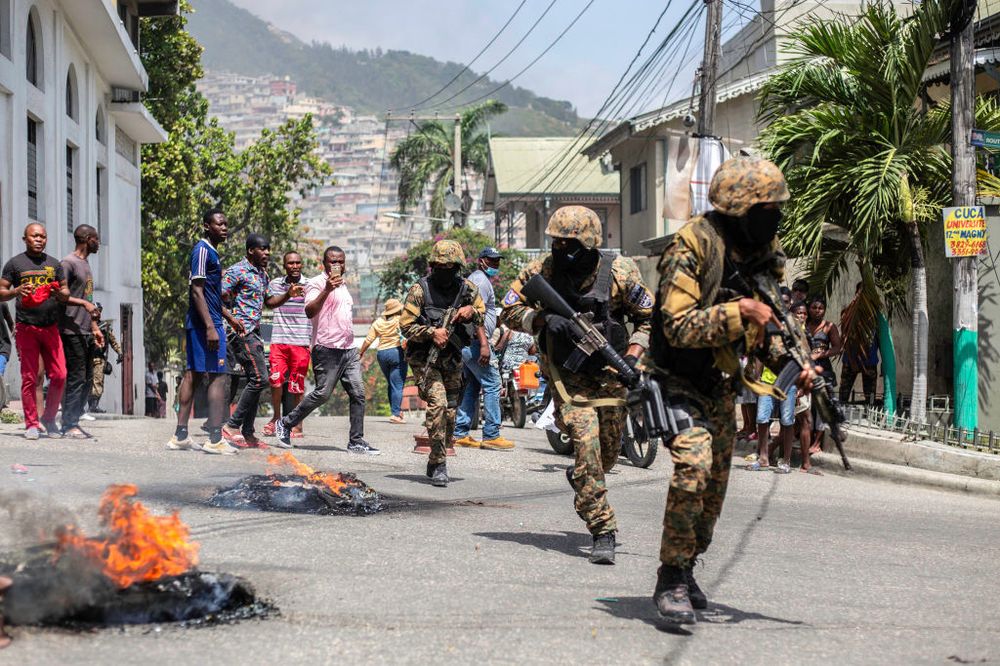By Eric Jenkins, Socialist Alternative (our sister organisation in the United States)
On July 7, Haitian President Jovenal Moïse was surrounded in his home by 28 “bodyguards”/mercenaries belonging to the Miami-based “CTU security”. Several then went inside of his home and shot him more than 12 times. Immediately, the shock from many Haitian people was also the confusion of how this assassination could be performed in such a brazen manner. Residents near Moïse’s home saw “commandos” with black masks and heavy weaponry, and some reported to hear machine-gun fire.
The death of President Moïse isn’t masked by any illusions in his legacy for most of Haiti’s masses. Moïse engaged in constant repression of the Haitian working class and poor. He and his clique have stolen millions from the PetroCaribe fund, and refused to step down as President to rule essentially by decree. Moïse employed armed paramilitary gangs along with police to kill and repress protestors during mass demonstrations as many Haitian activists and youth are all too familiar with.
But, the death of Moïse clearly has sparked fear for many Haitians. Safety in Haiti is a constant concern as gang violence accelerates, linked with the worsening economic situation for the majority of Haiti. If the President could be killed this easily in his own home, it means that no one in Haiti can be safe in their own home. Further, many Haitians are rightly suspicious of the present investigations surrounding the assassination of Moisie.
The investigation of Moïse’s assassination has been confusing for many ordinary Haitians. Christian Emmanuel Sanon, a 65-year-old Haitian doctor who was “called by God” to take over Haiti, was arrested and charged for being the supposed mastermind. Yet Sanon is unheard of in Haiti, and previously filed for bankruptcy, preventing him from launching a multi-million dollar coup attempt singlehandedly. A few days later, the head of Presidential Security was arrested by Haitian police, which sparked even more questions on how deep the assassination conspiracy goes. Missing witnesses destroyed evidence, and death threats to investigators clearly show that those in political power are hiding the truth of what happened.
Assassination of Moïse linked to ruling class divisions
Meanwhile, the Haitian ruling class battled over the empty Presidency spot. Minister of Foreign Affairs and former Prime Minister Claude Joseph rushed to take control, immediately declaring himself acting president, despite Prime Minister Ariel Henry being the next President according to the Haitian constitution. Joseph has since yielded his claim to the Presidency after the “Core Group”, a group of ambassadors that includes the United States, spoke in favor of Ariel Henry. This is despite the fact that only several days before, the Biden administration said they recognized Claude Joseph as acting Prime Minister and President!
All of this just confirms what ordinary Haitians know all too well, that the Haitian ruling class cannot be trusted, and that it dances to the tune of foreign Imperialist powers particularly the United States. This can be seen by Haitian protestors confronting a US delegation at Moïse’s funeral, calling for them to reveal who is truly responsible, and forcing them to flee from Haiti.
The assassination of Moïse shows a clear window into the disunity among the Haitian ruling elite. The majority of elected seats are empty because of the recent lack of elections, and election rigging is commonplace. Infighting has taken the form of gangs being used to assassinate and/or intimidate. Moïse was overstepping his power by refusing to step down as President, which many in the Haitian ruling class saw as a threat to their own power. None of them have the answers to the accelerating crisis that is facing Haiti and are solely interested in using the state for their own personal enrichment through either blatant corruption or clinging to US Imperialism and transnational corporations such as Coca-Cola.
Gang violence and economic crisis wreak devastation
The Haitian ruling class’s constant infighting in the midst of the economic and social crisis they are responsible for has only accelerated the devastation faced by many Haitian working and poor people.
Around 7 Million Haitians live under the poverty line making under US$2.41 per day. COVID-19 has impacted the country with the shutdown of the Haitian economy as supply chains deteriorated. More than 10,000 Haitian garment workers have been without work since before the pandemic, bringing the total garment workforce from 50,000 to 36,000. About 69% of households reported a decline in income, with more than half reporting a decline of more than 79%! Food and gasoline shortages are now a constant occurrence across Haiti but particularly in the capital, Port-au-Prince.
This has meant dire consequences for the youth of Haiti. More than half of the population, 11 million, are under the age of 25. Many cannot find work, and are forced to take on unsafe informal jobs and/or criminal activity or face starvation. Some join armed gangs that participate in kidnapping for money ransoms. Since 2020, there has been a 200% increase in kidnappings occurring in Haiti.
The devastation that this economic crisis is bringing has also radicalized an entire generation of Haitian youth, and can be seen even in the behavior in some of these gangs. The most prominent one being G9 Fanmi ak Alye (“Family and Allies”), a coalition of originally 9 gangs that has grown since, and its leader former Haitian police officer Jimmy “Barbecue‘’ Chérizier. Recently Chérizier has claimed to have launched a “revolutionary” struggle against the Haitian bourgeoisie and political elites. This is obviously not the case, as G9 and Chérizier are notorious for their violent repression of protestors against Moïse, and Chérizier was leading other armed gangs even while he was a Haitian police officer. However, the fact that Chérizier feels the need to use the rhetoric of being against the ruling elite shows the extent of intense anger held by the youth toward the government.
US imperialism & capitalism behind Haiti’s misery
The United States’ current political and economic domination of Haiti has brought about the crises that Haiti faces. The US is Haiti’s biggest trading partner, with the US flooding Haiti’s markets with cheap agricultural products or necessities such as energy and tools. US companies make billions of dollars in reducing Haiti to dependence on US companies for basic necessities. Haiti, once a rice exporter, now imports rice which 80% of the population consumes. Rural farmers aren’t able to compete with this and are subsequently forced out of their land and into Port-au-Prince as unemployed workers.
In “return”, Haiti exports primarily to the United States as well, accounting for up to $1.6 billion, despite being portrayed as a “poor” nation. Free-trade zones littered across Haiti allow companies who operate in these zones to not pay any taxes on income for up to 15 years. The garment industry produces millions of pieces of cloth (making up 90% of Haitian export earnings in 2015) that are shipped mainly to the US waived of any tariffs. Haiti is treated as a cash-cow, with US companies flooding the market with cheap goods, and a cheap pool of labor to engage in back-breaking work. Haiti is trapped in neo-colonial subjugation to the United States.
The US has a long history of invading and interfering in Haiti. In 1915–1935, the US invaded Haiti and placed it under military occupation to protect US investors profits. Subsequently, the US took over the Haitian National Bank, rewriting the constitution to allow foreigners to own private land, and giving away huge farmlands from the native landowning classes (many who descended from Haitian generals during the Haitian revolution) to huge US companies like United Fruit.
Ever since, both the Haitian political elite and the oligarchs look to the United States as the real master of Haiti. This was shown again when Aristide, former leader of Lavalas and President of Haiti, was deposed with the assistance of the US ruling class in 1991. Aristide was then reinstalled in 1994 by President Clinton as he surrounded Haiti with 15,000 troops! The horrific earthquake of 2010 saw Bill and Hillary Clinton and their multiple foundations pour nearly $600 million into Haiti, becoming the most important political figures in Haiti for several years. The majority of the money to “rebuild Haiti‘’, up to $16.1 billion, hasn’t been seen by the majority of Haiti’s working and poor people. More recently Biden has tweeted regarding Haiti’s crisis “Mwen ka di sa byen kle: pa vini”, meaning “I can say quite clearly, don’t come over”.
US Imperialism is rooted in the core logic of capitalism: to generate as much profit for the bosses as possible. The misery that many Haitians are forced to go through day-to-day is rooted in poor living conditions, little to no opportunity for decent work, poor housing, and subpar food. Capitalists know this, and it’s in fact a selling point for many companies: A US government website, Trade.gov, notes how “the labor eligible population has a strong desire for work… with factory managers reporting low levels of absenteeism (2 percent) and turnover between 4 percent and 6 percent per year”. The goal of all of the misery that Haiti is going through is to create a cheap labor force to exploit, transforming Haiti into a giant warehouse with millions of unemployed Haitians lying in wait outside of its gates for a chance of a decent life. This tips the scale in favor of the Capitalists, who don’t want to deal with fighting against a confident, organized working class who recognize their power and refuse to give up their dignity. US Imperialism forces those conditions onto the masses, using the political elite and the oligarchs as tools.
Permanent revolution, The role of the working Class & the way forward
Haiti is described constantly as a place without a future or hope, but this is hardly the case. What it shows is that the capitalist ruling clique of Haiti are completely unable to create even a functional democracy for the Haitian masses. Constantly, the masses of Haiti, led by the working class, fought against both dictators and US imperialism.
Leon Trotsky, one of the leaders of the Bolshevik party who led the Russian working class to overthrow Capitalism in October 1917, describes this dynamic process as one of “Permanent Revolution”. The bourgeoisie of countries underdeveloped by imperialism and capitalism cannot deliver democratic rights for the masses of working and poor people; instead relying on anti-democratic institutions such as feudal remnants or military dictatorships who are bound with capitalism and support from Imperialist powers. In order to overthrow these regimes, it’s then necessary to remove its basis: capitalism. This puts the working class in the position of being the only class that can complete these tasks, as they are the only ones that can battle against the bosses and political elite via workplace action and mass demonstrations. The struggle for democratic rights becomes the struggle for socialism and would inspire working-class people across the world to struggle against their own capitalist exploiters and undemocratic regimes.
Haiti since the 1804 revolution has shown the possibility of a successful revolution of the oppressed spreading across the globe. Many still write about the Haitian revolution and the creation of the first “Black Republic”. A successful mass movement in Haiti can spread like wildfire across Latin America, the Carribean, and particularly the United States, which the capitalists class fears. This is why Colombia in the Organization of American States is calling for military intervention in Haiti under the guise of “keeping stability”, when in reality its to crush any Haitian working class movement.
Haiti’s working class is a giant that has often been overlooked. It led the way during the 1946 revolution with a general strike that ousted the then Dictator Elie Lescot after police repressed a student strike. Jean-Claude Duvalier, aka “Baby Doc”, was overthrown in 1986 through a general strike and mass mobilizations. The Moïse government was trapped in a virtual impasse due to the consistent general strikes from 2018–2021. Each victory was not consolidated by the working class because of the absence of a revolutionary party to point to the necessity of liquidating capitalism and the oligarchs by calling for the Haitian workers to seize political power.
What is necessary now is the coalescing of Haitian activists, union members, workers and poor into a mass political party that engages in active struggle against the political elite, US imperialism, and the capitalist bosses. All politicians linked to this party should accept the average worker’s wage and be immediately recallable, as this would ensure that working class representatives will not disintegrate into the ocean of opportunist Haitian politicians. NGO money has no place in the movement, as we see the US companies and politicians use this cash to control movements in Haiti. This party could fight for the nationalization of Haitian ports, the garment industry, increasing the minimum wage, ensuring the right to unionize, the elimination of the Free Trade zones, ending unfair trade pacts, and providing subsidies to struggling rural farmers.
Young Haitians who are seduced into gang activity cannot be abandoned. A mass workers party in Haiti can appeal to the youth to take their place in the struggle to obtain a decent life rather than terrorize their community. Protestors and activists can create mass community meetings to discuss how to create community self-defense against government-hired paramilitary gangs who attack organizers, activists, and protestors.
To end the misery of the Haitian masses, there is a need for revolutionary socialist leadership to be at the head of any form of mass organization of the working class. An international approach, calling for a voluntary and equal socialist federation of the Caribbean to stand up against the Imperialist powers, and to fight for the liberation of humanity via international socialist revolution.











